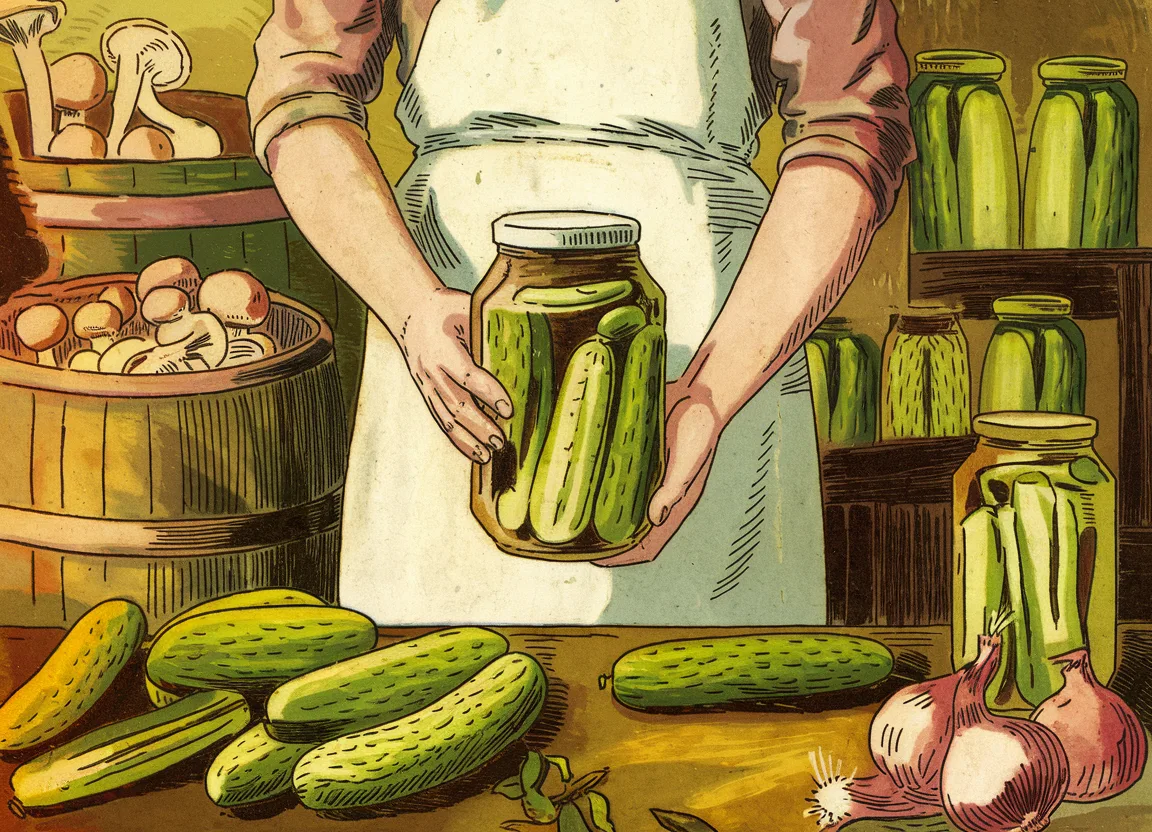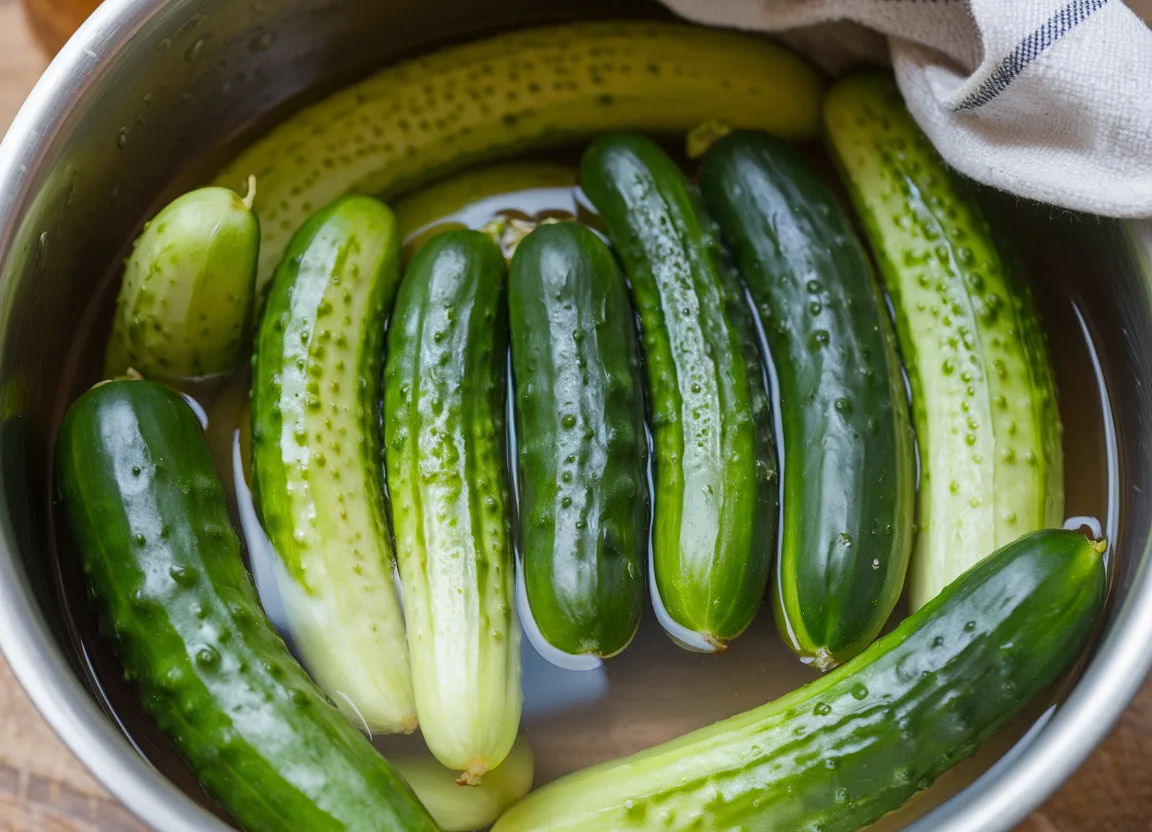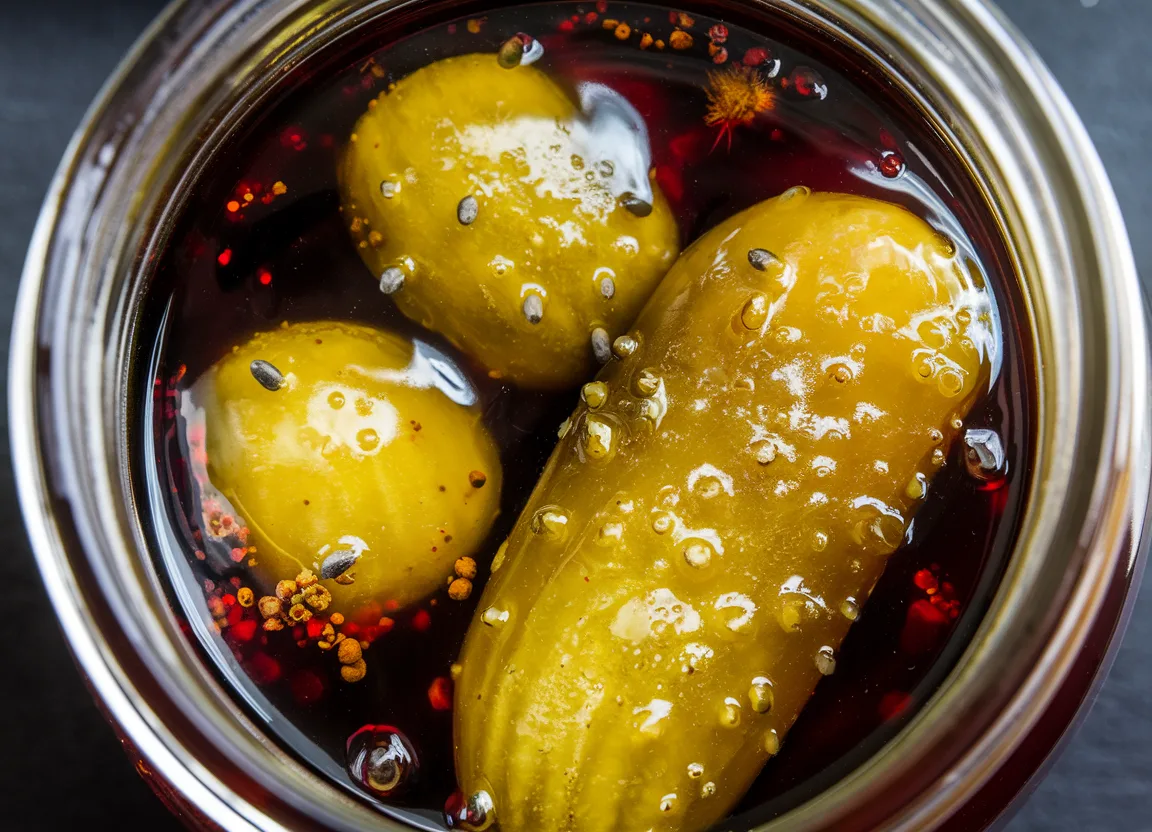The art of making sweet pickles is a culinary journey worth embarking on. It’s a process that combines science, tradition, and a dash of creativity.
Sweet pickles, with their delightful blend of sweet and tangy flavors, are a staple in many kitchens. They add a unique touch to sandwiches, salads, and even cocktails.
But have you ever thought about making your own sweet pickles at home?
This guide will take you through the process, step by step. From selecting the right cucumbers to creating the perfect brine, we’ve got you covered.
You’ll also learn about the history of pickling and the health benefits of homemade pickles. Plus, we’ll share some variations of the sweet pickles recipe for you to try.
Whether you’re a seasoned home cook or a beginner, this guide is for you.
So, are you ready to dive into the world of homemade sweet pickles? Let’s get started.
The Sweet History of Pickling
Pickling is an ancient culinary practice that dates back thousands of years. It was a practical method used to preserve food, especially during times of scarcity.

The process of pickling involves immersing food in a solution, usually vinegar or brine. This not only extends the food’s shelf life but also enhances its flavor. Sweet pickles, in particular, are a delightful blend of sweet, sour, and salty flavors.
The art of pickling has evolved over the centuries, with different cultures adding their unique touch. Today, making sweet pickles at home is a cherished tradition for many, a nod to the past, and a testament to the enduring appeal of this humble preserved food.
Health Benefits of Homemade Sweet Pickles
Homemade sweet pickles are not just a tasty treat, they also offer several health benefits. For starters, they are a good source of essential vitamins and minerals, including vitamin K, vitamin A, and iron.

Moreover, pickles made at home are free from artificial preservatives and additives often found in store-bought versions. This makes them a healthier choice for those who are conscious about what they eat.
Lastly, the vinegar used in pickling can have probiotic properties, promoting a healthy gut. However, it’s important to note that not all pickles have probiotics, as the canning process can kill these beneficial bacteria.
Essential Ingredients for Sweet Pickles
Creating sweet pickles at home requires a few key ingredients. The main ingredient, of course, is cucumbers. Fresh, firm cucumbers are the best choice for pickling.
The other essential ingredients are vinegar and sugar. Vinegar acts as a preservative, while sugar gives the pickles their sweet taste. The type of vinegar and the amount of sugar can be adjusted according to personal preference.
Here is a basic list of ingredients for a simple sweet pickles recipe:
- Fresh cucumbers
- White vinegar
- Sugar
- Salt
- Water
- Optional flavorings (such as dill, garlic, or mustard seeds)
Remember, the quality of your ingredients will directly affect the taste of your pickles. So, always choose the freshest and best quality ingredients you can find.
Selecting the Right Cucumbers
Choosing the right cucumbers is crucial for making great sweet pickles. The best cucumbers for pickling are small to medium-sized, with a firm texture and bright green color.
Avoid cucumbers with blemishes or soft spots, as they can affect the quality of your pickles. Also, remember to wash your cucumbers thoroughly before pickling to remove any dirt or pesticides.
Equipment Checklist for Pickling
Before you start pickling, it’s important to gather all the necessary equipment. Having everything at hand will make the process smoother and more enjoyable.
Here’s a basic checklist of what you’ll need:
- Large pot for boiling water
- Canning jars with lids and bands
- Jar lifter
- Funnel
- Ladle
- Clean cloths or paper towels
- Cutting board and knife
- Bowl for mixing brine
Remember, all equipment should be clean and free from any soap residue. This is crucial to prevent any unwanted bacteria from spoiling your sweet pickles.
Preparing Your Cucumbers for Pickling
The first step in making sweet pickles is preparing the cucumbers. This is a crucial step that can greatly affect the final product.
Start by washing your cucumbers thoroughly under cold water. This will remove any dirt or debris. It’s important to use fresh, firm cucumbers for pickling. Avoid any with blemishes or soft spots.
Next, cut off the blossom end of the cucumber. This end contains enzymes that can make your pickles soft. Then, slice your cucumbers into your desired shape. You can cut them into rounds, spears, or leave them whole. Just remember, the smaller the pieces, the faster they will pickle.
Now, your cucumbers are ready for pickling. The next step is creating the perfect sweet pickle brine.
Crafting the Perfect Sweet Pickle Brine
The brine is the heart of any pickle recipe. It’s what gives the pickles their distinctive sweet and tangy flavor.
The basic ingredients for a sweet pickle brine are vinegar, sugar, and salt. Vinegar provides the acidity needed for preservation, while sugar and salt add flavor.
Here’s a simple recipe for sweet pickle brine:
- 2 cups of vinegar (white or apple cider)
- 1.5 cups of sugar
- 1/4 cup of pickling salt
Start by combining the vinegar, sugar, and salt in a pot. Bring the mixture to a boil, stirring until the sugar and salt dissolve. Once the brine is ready, it’s time to add your cucumbers and any additional flavorings.
Remember, the brine is also a great place to get creative. Feel free to experiment with different types of vinegar, or add spices like mustard seeds, dill, or garlic for extra flavor. The possibilities are endless when it comes to crafting your perfect sweet pickle brine.
The Pickling Process Explained
Pickling is a fascinating process. It’s a method of preservation that has been used for centuries to extend the shelf life of foods.
The first step in the pickling process is to prepare your cucumbers. This involves washing them thoroughly and cutting them into your desired shape. Some people prefer whole pickles, while others like slices or spears.
Next, you’ll need to prepare your brine. As we discussed earlier, the brine is a mixture of vinegar, sugar, and salt. You’ll bring this mixture to a boil and then pour it over your prepared cucumbers.
The cucumbers then need to be left to soak in the brine. The length of time they soak will depend on the recipe you’re following, but generally, the longer they soak, the stronger the flavor will be.
Finally, once the cucumbers have soaked in the brine for the appropriate amount of time, they’re ready to be canned. This involves placing them in sterilized jars, covering them with the remaining brine, and then sealing the jars. The jars are then processed in a water bath to ensure they’re sealed properly and safe for long-term storage.
Canning Sweet Pickles: A Step-by-Step Guide
Canning sweet pickles is a rewarding process. It allows you to enjoy your homemade pickles for months to come.
Here’s a step-by-step guide to canning sweet pickles:
- Prepare your cucumbers and brine as described in the previous sections.
- Sterilize your jars and lids.
- Fill the jars with cucumbers and brine using the hot fill process.
- Process the jars in a water bath.
- Check the seals and store the jars in a cool, dark place.
Each of these steps is crucial to ensure the safety and quality of your pickles.
Sterilizing Your Jars and Lids
Before you can start canning, you need to sterilize your jars and lids. This is a crucial step to prevent any bacteria or mold from contaminating your pickles.
You can sterilize your jars by washing them in hot, soapy water and then boiling them for 10 minutes. The lids should be washed in hot, soapy water and then kept in hot (not boiling) water until you’re ready to use them.
The Hot Fill Process
The hot fill process involves filling your sterilized jars with the cucumbers and hot brine. This process helps to kill any remaining bacteria and ensures a good seal on the jars.
Once the jars are filled, wipe the rims with a clean cloth to remove any residue. Then, place the lids on the jars and screw on the bands until they’re fingertip tight.
The Water Bath Canning Method
The final step in the canning process is the water bath. This involves submerging the filled jars in boiling water for a set amount of time.
The jars should be covered by at least an inch of water. The processing time will depend on the recipe you’re following and the size of your jars. Once the processing time is up, remove the jars from the water and let them cool. As they cool, you should hear a popping sound as the lids seal.
Ensuring Safety and Quality
When it comes to canning sweet pickles, safety and quality are paramount. It’s essential to follow the steps outlined above to ensure your pickles are safe to eat and taste great.
Firstly, always check the seals on your jars after they’ve cooled. The lids should be concave and not move when pressed. If a jar hasn’t sealed properly, refrigerate it and consume the pickles within a few weeks.
Secondly, store your canned pickles in a cool, dark place. This helps to maintain their quality and extends their shelf life. Finally, remember that patience is key. Allow your pickles to cure for at least a week before tasting them. This gives the flavors time to develop and results in a better tasting pickle.
Storing and Curing Your Sweet Pickles
Once your jars are sealed and cooled, it’s time to store them. The best place for your sweet pickles is a cool, dark, and dry area. This could be a pantry, a cellar, or a basement.
The temperature should ideally be between 50 and 70 degrees Fahrenheit. Avoid areas with high heat or direct sunlight as these conditions can degrade the quality of your pickles over time.
Curing is the final step in the pickling process. This is when the flavors meld together and the pickles reach their peak taste. For sweet pickles, a curing period of 4 to 6 weeks is recommended. However, if you can’t wait that long, a minimum of one week should suffice. Remember, the longer they cure, the better they taste.
Sweet Pickle Variations: Mixed and Sweet and Sour
The beauty of making your own sweet pickles is the ability to experiment with flavors. Two popular variations are mixed sweet pickles and sweet and sour pickles.
Mixed sweet pickles are a delightful blend of cucumbers, onions, bell peppers, and cauliflower. The vegetables are pickled together, creating a colorful and flavorful mix. Here’s a simple way to make them:
- Follow the basic sweet pickles recipe.
- Add 1 cup of sliced onions, 1 cup of chopped bell peppers, and 1 cup of cauliflower florets to the cucumbers before pickling.
Sweet and sour pickles, on the other hand, offer a tangy twist to the classic sweet pickle. The addition of extra vinegar gives these pickles their distinctive sour punch. To make sweet and sour pickles:
- Increase the vinegar in your brine by 1/2 cup.
- Decrease the sugar by 1/2 cup.
Remember, these are just starting points. Feel free to adjust the ingredients to suit your taste. Happy pickling!
Troubleshooting Common Pickling Problems
Even with the best intentions, pickling can sometimes go awry. But don’t worry, most issues are easy to fix.
One common problem is pickles turning out too soft or mushy. This can be due to overcooking or using overripe cucumbers. To prevent this, always use fresh, firm cucumbers and avoid overcooking during the canning process. Adding a source of tannins, like grape leaves or black tea, can also help maintain crispness.
Another issue is cloudiness in the brine. This can be caused by minerals in the water or by using table salt instead of pickling salt. Always use distilled water and pickling salt to ensure a clear brine.
Lastly, if your pickles have a strange or off taste, it could be due to the quality of your ingredients. Always use fresh, high-quality produce and spices for the best results. Happy troubleshooting!
Serving and Enjoying Your Sweet Pickles
Now that you’ve mastered the art of making sweet pickles, it’s time to enjoy them!
Sweet pickles are incredibly versatile and can be used in a variety of dishes. They make a great addition to sandwiches, burgers, and hot dogs, adding a sweet and tangy crunch that complements the savory flavors.
They can also be chopped up and used in salads, like potato salad or coleslaw, for an unexpected twist. Or, serve them on a charcuterie board with cheeses and cured meats for a delightful contrast in flavors.
Remember, the joy of homemade sweet pickles isn’t just in the making, but also in the sharing. So, don’t forget to share your sweet pickles with friends and family. They’ll be impressed by your culinary skills and the delicious taste of your homemade sweet pickles.
Conclusion: The Joy of Homemade Sweet Pickles
Making sweet pickles at home is a rewarding experience. It’s a blend of science and art, tradition and innovation.
The joy of homemade sweet pickles lies not just in the delicious end product, but also in the process. It’s about taking simple, fresh ingredients and transforming them into something extraordinary. It’s about the satisfaction of creating something from scratch, and the pride of sharing your homemade creations with others. So, embrace the art of making sweet pickles, and enjoy the sweet rewards of your labor.
